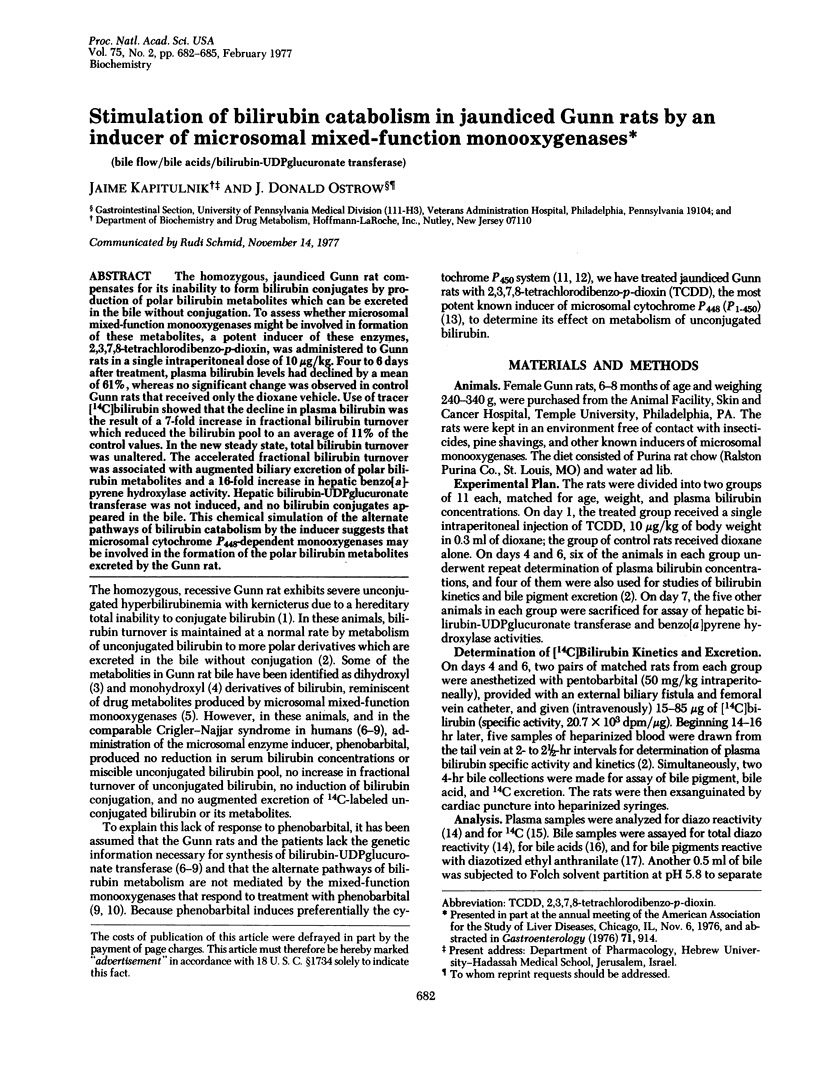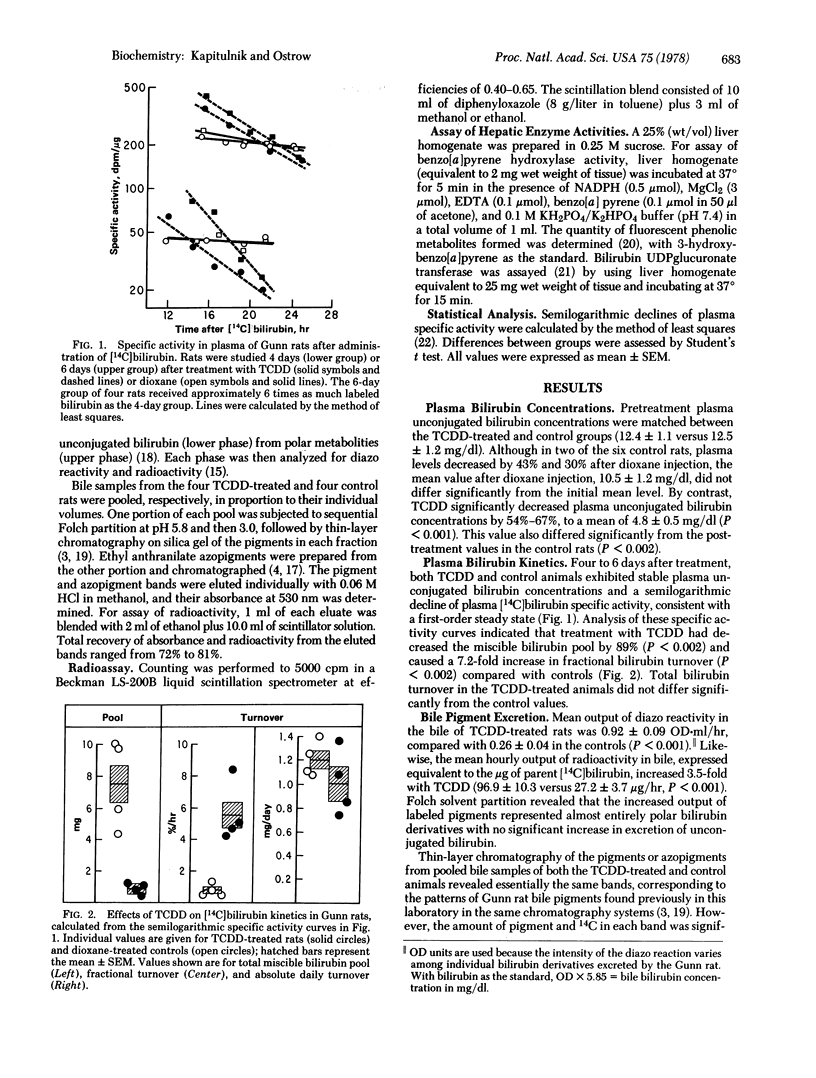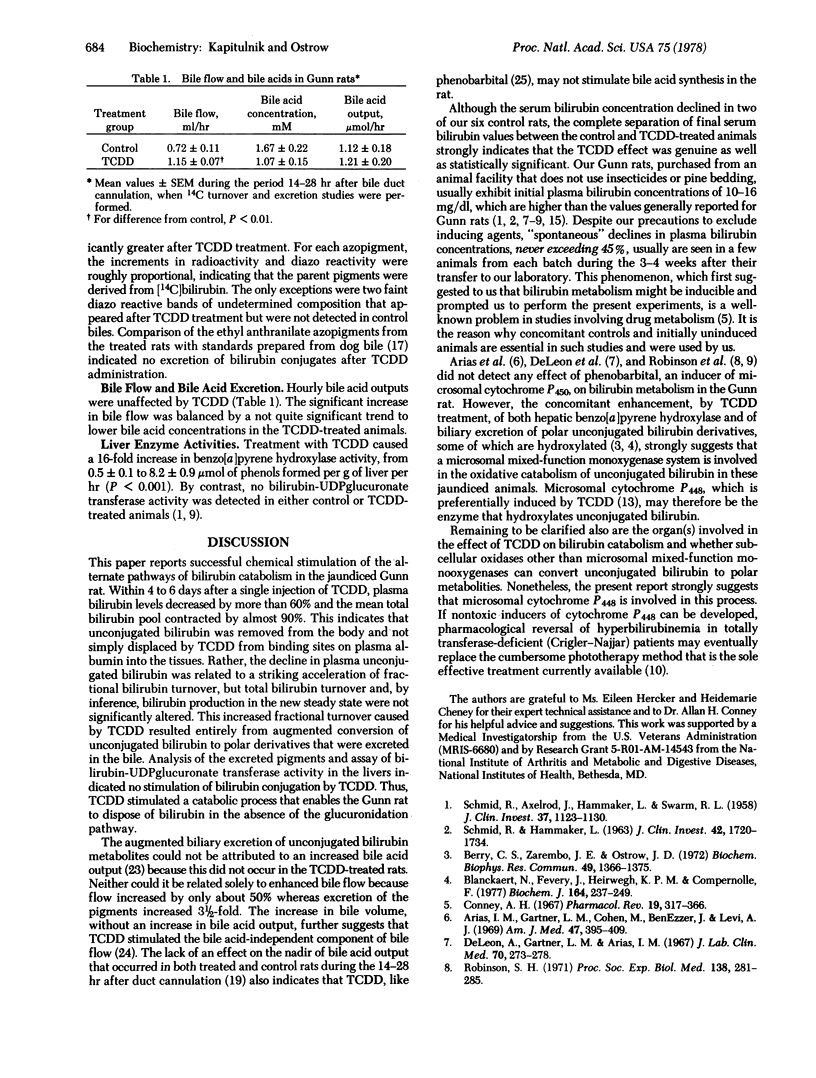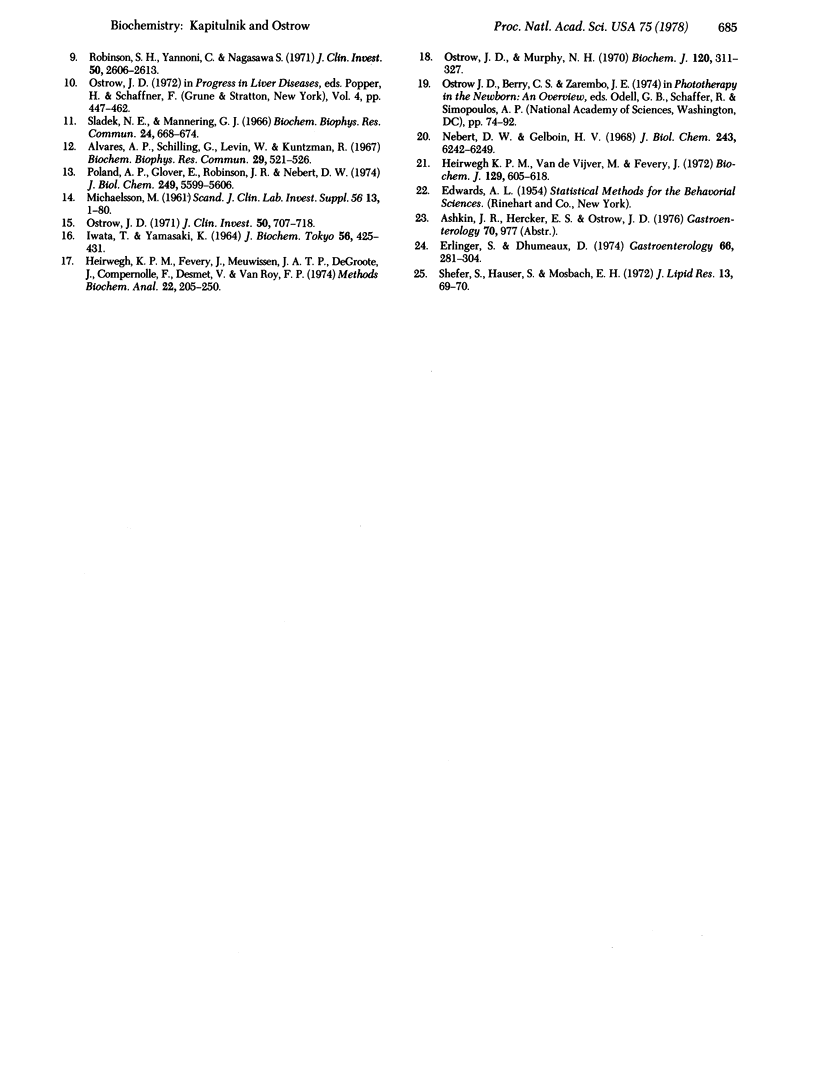Abstract
The homozygous, jaundiced Gunn rat compensates for its inability to form bilirubin conjugates by production of polar bilirubin metabolites which can be excreted in the bile without conjugation. To assess whether microsomal mixed-function monooxygenases might be involved in formation of these metabolites, a potent inducer of these enzymes, 2,3,7,8-tetrachlorodibenzo-p-dioxin, was administered to Gunn rats in a single intraperitoneal dose of 10 μg/kg. Four to 6 days after treatment, plasma bilirubin levels had declined by a mean of 61%, whereas no significant change was observed in control Gunn rats that received only the dioxane vehicle. Use of tracer [14C]bilirubin showed that the decline in plasma bilirubin was the result of a 7-fold increase in fractional bilirubin turnover which reduced the bilirubin pool to an average of 11% of the control values. In the new steady state, total bilirubin turnover was unaltered. The accelerated fractional bilirubin turnover was associated with augmented biliary excretion of polar bilirubin metabolites and a 16-fold increase in hepatic benzo[a]-pyrene hydroxylase activity. Hepatic bilirubin-UDPglucuronate transferase was not induced, and no bilirubin conjugates appeared in the bile. This chemical simulation of the alternate pathways of bilirubin catabolism by the inducer suggests that microsomal cytochrome P448-dependent monooxygenases may be involved in the formation of the polar bilirubin metabolites excreted by the Gunn rat.
Keywords: bile flow, bile acids, bilirubin-UDPglucuronate transferase
Full text
PDF



Selected References
These references are in PubMed. This may not be the complete list of references from this article.
- Alvares A. P., Schilling G., Levin W., Kuntzman R. Studies on the induction of CO-binding pigments in liver microsomes by phenobarbital and 3-methylcholanthrene. Biochem Biophys Res Commun. 1967 Nov 30;29(4):521–526. doi: 10.1016/0006-291x(67)90515-3. [DOI] [PubMed] [Google Scholar]
- Arias I. M., Gartner L. M., Cohen M., Ezzer J. B., Levi A. J. Chronic nonhemolytic unconjugated hyperbilirubinemia with glucuronyl transferase deficiency. Clinical, biochemical, pharmacologic and genetic evidence for heterogeneity. Am J Med. 1969 Sep;47(3):395–409. doi: 10.1016/0002-9343(69)90224-1. [DOI] [PubMed] [Google Scholar]
- Berry C. S., Zarembo J. E., Ostrow J. D. Evidence for conversion of bilirubin to dihydroxyl derivatives in the gunn rat. Biochem Biophys Res Commun. 1972 Dec 4;49(5):1366–1375. doi: 10.1016/0006-291x(72)90617-1. [DOI] [PubMed] [Google Scholar]
- Blanckaert N., Fevery J., Heirwegh K. P., Compernolle F. Characterization of the major diazo-positive pigments in bile of homozygous Gunn rats. Biochem J. 1977 Apr 15;164(1):237–249. doi: 10.1042/bj1640237. [DOI] [PMC free article] [PubMed] [Google Scholar]
- Conney A. H. Pharmacological implications of microsomal enzyme induction. Pharmacol Rev. 1967 Sep;19(3):317–366. [PubMed] [Google Scholar]
- DeLeon A., Gartner L. M., Arias I. M. The effect of phenobarbital on hyperbilirubinemia in glucuronyl transferase deficient rats. J Lab Clin Med. 1967 Aug;70(2):273–278. [PubMed] [Google Scholar]
- Erlinger S., Dhumeaux D. Mechanisms and control of secretion of bile water and electrolytes. Gastroenterology. 1974 Feb;66(2):281–304. [PubMed] [Google Scholar]
- Heirwegh K. P., Fevery J., Meuwissen J. A., De Groote J., Compernolle F., Desmet V., Van Roy F. P. Recent advances in the separation and analysis of diazo-positive bile pigments. Methods Biochem Anal. 1974;22:205–250. doi: 10.1002/9780470110423.ch5. [DOI] [PubMed] [Google Scholar]
- Heirwegh K. P., Van de Vijver M., Fevery J. Assay and properties of dititonin-activated bilirubin uridine diphosphate glucuronyltransferase from rat liver. Biochem J. 1972 Sep;129(3):605–618. doi: 10.1042/bj1290605. [DOI] [PMC free article] [PubMed] [Google Scholar]
- IWATA T., YAMASAKI K. ENZYMATIC DETERMINATION AND THIN-LAYER CHROMATOGRAPHY OF BILE ACIDS IN BLOOD. J Biochem. 1964 Nov;56:424–431. doi: 10.1093/oxfordjournals.jbchem.a128013. [DOI] [PubMed] [Google Scholar]
- Nebert D. W., Gelboin H. V. Substrate-inducible microsomal aryl hydroxylase in mammalian cell culture. I. Assay and properties of induced enzyme. J Biol Chem. 1968 Dec 10;243(23):6242–6249. [PubMed] [Google Scholar]
- Ostrow J. D., Murphy N. H. Isolation and properties of conjugated bilirubin from bile. Biochem J. 1970 Nov;120(2):311–327. doi: 10.1042/bj1200311. [DOI] [PMC free article] [PubMed] [Google Scholar]
- Ostrow J. D. Photocatabolism of labeled bilirubin in the congenitally jaundiced (Gunn) rat. J Clin Invest. 1971 Mar;50(3):707–718. doi: 10.1172/JCI106541. [DOI] [PMC free article] [PubMed] [Google Scholar]
- Poland A. P., Glover E., Robinson J. R., Nebert D. W. Genetic expression of aryl hydrocarbon hydroxylase activity. Induction of monooxygenase activities and cytochrome P1-450 formation by 2,3,7,8-tetrachlorodibenzo-p-dioxin in mice genetically "nonresponsive" to other aromatic hydrocarbons. J Biol Chem. 1974 Sep 10;249(17):5599–5606. [PubMed] [Google Scholar]
- Robinson S. H. Production and excretion of bilirubin in Gunn rats treated with phenobarbital. Proc Soc Exp Biol Med. 1971 Oct;138(1):281–284. doi: 10.3181/00379727-138-35879. [DOI] [PubMed] [Google Scholar]
- Robinson S. H., Yannoni C., Nagasawa S. Bilirubin excretion in rats with normal and impaired bilirubin conjugation: effect of phenobarbital. J Clin Invest. 1971 Dec;50(12):2606–2613. doi: 10.1172/JCI106761. [DOI] [PMC free article] [PubMed] [Google Scholar]
- SCHMID R., AXELROD J., HAMMAKER L., SWARM R. L. Congenital jaundice in rats, due to a defect in glucuronide formation. J Clin Invest. 1958 Aug;37(8):1123–1130. doi: 10.1172/JCI103702. [DOI] [PMC free article] [PubMed] [Google Scholar]
- SCHMID R., HAMMAKER L. METABOLISM AND DISPOSITION OF C14-BILIRUBIN IN CONGENITAL NONHEMOLYTIC JAUNDICE. J Clin Invest. 1963 Nov;42:1720–1734. doi: 10.1172/JCI104858. [DOI] [PMC free article] [PubMed] [Google Scholar]
- Shefer S., Hauser S., Mosbach E. H. Stimulation of cholesterol 7 -hydroxylase by phenobarbital in two strains of rats. J Lipid Res. 1972 Jan;13(1):69–70. [PubMed] [Google Scholar]
- Sladek N. E., Mannering G. J. Evidence for a new P-450 hemoprotein in hepatic microsomes from methylcholanthrene treated rats. Biochem Biophys Res Commun. 1966 Sep 8;24(5):668–674. doi: 10.1016/0006-291x(66)90376-7. [DOI] [PubMed] [Google Scholar]


